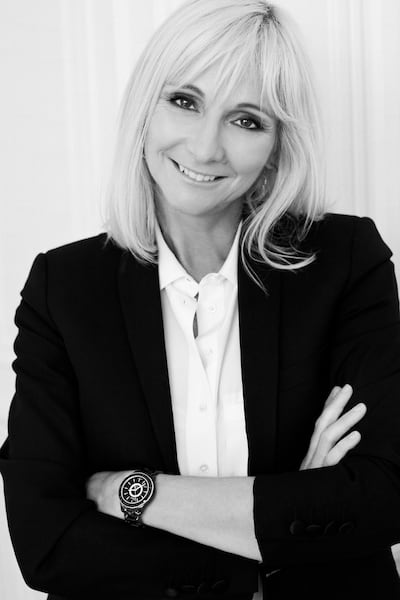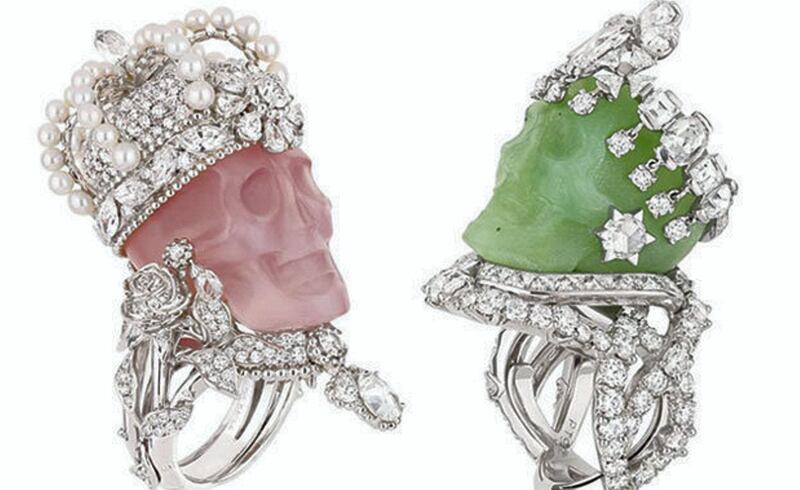Dressed in black head-to-toe Dior, including a chunky gold ring from the Nougat collection, which houses a watch within, Laurence Nicolas looks every bit the polished Parisienne when I meet her in Dubai. "I quite like the idea of reading time like this," she says, holding up her bejewelled hand, "instead of looking sideways every time." Yet, the global managing director of jewellery and watches at Sotheby's always carries in her purse a traditional timepiece: the Dandy watch that her husband created from scratch and gave her 15 years ago.
“My husband is fascinated with contemporary art, which reflects in the design of this watch – a round dial in a square case, with a tuxedo pattern running vertically across,” she says. Art forms a big part of her own aesthetic, apparent from the watches and jewels she lists among her favourite, notably the Dalí-inspired asymmetric Crash watch from Cartier, and rings and brooches from Dior’s King & Queens collection, pieces that take the shape of crown-donning skulls, in a nod to the Vanity period in painting. It’s a suitable connection to Nicolas’s position at Sotheby’s, the 274-year-old New York-headquartered corporation, which is known, above all, for its connections with the art world.
When I ask the former CEO of Dior Timepieces & Fine Jewellery how the Sotheby’s position came about, she draws a parallel between her current role and the decision to move years ago from Cartier to Dior, and indeed from fashion to what she considers the arts. “After 11 years at Cartier,” she begins, “I was not… bored, but it was easy. I didn’t feel like I was instrumental to anything. When I was hunted to create, from scratch, jewellery with Dior alongside Victoire [de Castellane], who had just joined from Chanel, and with the support of Mr [LVMH head Bernard] Arnault, I jumped for it. It was my dream job; 17 years later, I was still having fun. And, honestly for me, Sotheby’s was the only company that could grab me away from that, because leaving Dior to go back to Cartier or Boucheron, Chaumet, Winston or Tiffany, would have been a flat learning curve.

“Also, I left the fashion community to enter the artistic one deliberately. I love fashion, of course, but I think it’s more short-cycle; every three months, you need or want a change. What I like about jewellery and timepieces is that, like art, they give you a longer-lasting experience. That pace and patrimonial approach is interesting to me.”
She does admit, theatrically pointing to her barely-there wrinkles, that the Sotheby's role – which was created specifically for her – does come with its fair share of challenges and expectations. "There is a lot of pressure. When you have a brand with more than 200 years of history, you need to continue the revolution, yet work out how to enter the millennial world as well. We have invested in some small but high-tech brands, such as Thread Genius and Mei Moses Art Indices, which are digital-oriented. I think the new generation is seeking something that has a unique experience around it. It's not only about the product you sell, but the overall experience, whether in bricks-and-mortar retail or via a digital boutique. And with existing clients, many of whom are from the Middle East, and are those who invest so much into their collections, it's important to create a long-lasting bond. It's going to be exciting to work out how we can become the ultimate marketplace for jewels and watches."
Nicolas was born in Madagascar and spent most of her formative years on the island nation, as well as travelling across Africa with her veterinarian father. She narrates, with equal relish, tales of growing up surrounded by baby elephants and leopard cubs, as well as making an early acquaintance with precious stones. “I remember once we were driving across Madagascar to attend to some wild beast or the other. In order to keep the car still on a steep slope, my father locked the wheels with a boulder-sized piece of amethyst, obtained from just around the corner. It was incredible. Africa is such a rich continent for gems; my passion and affinity for them comes from there.”
Nicolas, who lists pink diamonds as her favourite type of gemstone, will also oversee Sotheby's Diamonds, a wing that's independent of the auction business. The company sources the highest quality stones and works on a peer-to-peer basis to match individual stones to collectors. The venture is the result of a partnership with Diacore, a world leader in sourcing, cutting and polishing diamonds – the 203-carat De Beers Millennium Star and 59.60-carat Pink Star are cases in point. "I am fascinated by the craftsman and the stone-plater, and the kind of detail and artistry they bring. Diamonds are, of course, a commodity, but that's not my vision for it. Personally, I would not buy one only if it's an investment; it's not fun. Maybe it's because women need to have sentiment, beauty and craftsmanship – something you can pass to your children, aesthetics-wise, and yet that will hold its value."
It’s this valuable combination that Nicolas hopes to share with the Sotheby’s customer, who can access world-leading specialists such as jewellery savant David Bennet and head of watches Daryn Schnipper, who are neutral and objective because “they don’t personally have anything to gain whether one brand sells more or less than another”, says Nicolas. “We need to educate and reassure our customers about how seamless the auction or sales process can be, hand-hold them through the experience, curate their precious collections and, crucially, build a relationship of trust that, like a diamond, lasts forever.”
_______________
Read more:
[ Chopard adds first handbag to Happy Diamonds collection ]
[ William Dalrymple reveals the dark secrets of the Koh-i-Noor diamond ]
[ Of tribal cuffs and tanzanite stones: jeweller Amina Ghali reveals her favourites ]
_______________







